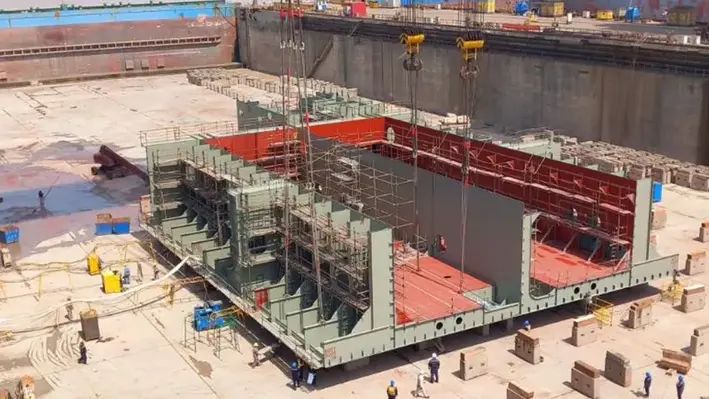 Offshore contractor Allseas — which has been tasked with decommissioning work in the Bass Strait for ExxonMobil Australia — is expanding its fleet.
Offshore contractor Allseas — which has been tasked with decommissioning work in the Bass Strait for ExxonMobil Australia — is expanding its fleet.
Its new cargo barge, Braveheart, which is being added to the fleet to boost flexibility for heavy lift campaigns, is now taking shape at the CIMC Changhong Shipyard near Shanghai in China.
Following official keel laying in April, the first of 145 huge steel blocks – together weighing a massive 26,000 tonnes – has been lifted into the dry dock for assembly, outfitting and painting.
At 200 metres long and 57 metres wide, it’s a close match to another Allseas barge, Iron Lady, but with key enhancements: a deeper operational draught, a full electric ballast system for faster load transfer operations and a significantly higher deck load capacity.
Together, Allseas’ trio of purpose-built cargo barges — Iron Lady, Braveheart and Bumblebee — will support the company’s platform removal and installation operations, delivering efficient topsides and jackets loading and transfer solutions to and from disposal yards.
The company has already started planning and preparation for what will be the largest offshore decommissioning assignment in Australian yet on behalf of Exxon subsidiary, Esso Australia Pty Ltd.
Allseas last year secured the contract to remove up to 12 retired platforms from the Gippsland Basin in the Bass Strait, with a combined weight of approximately 60,000 tonnes.
It plans to remove all the structures with another vessel, Pioneering Spirit — currently active in the North Sea — during an intense campaign beginning in late 2027.
Once safely removed, the facilities will be transferred to barges or vessels for load-in to the Barry Beach Marine Terminal in Victoria for dismantling and recycling by a separate onshore contractor.
In the meantime, Allseas is expanding its fleet with the Braveheart barge, which is expected to launch this September, with delivery scheduled at the end of 2025.
At the Chinese shipyard, the first construction phase in the dock focuses on the bottom section of the ballast pump room housing critical equipment.
Installing these blocks first allows the yard to immediately begin fitting the 1.5-metre diameter ballast pipes and four powerful ballast pumps, capable of moving nearly 10 Olympic-sized swimming pools' worth of water every hour.
Once this phase is complete, construction will move on to phase two: assembling the engine room.
Allseas also announced this month two further newbuild offshore construction vessels to enhance its fleet, to be built by Wuchang Shipbuilding Industry Group in China.




